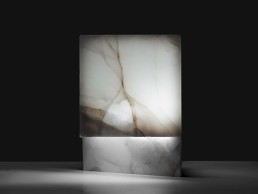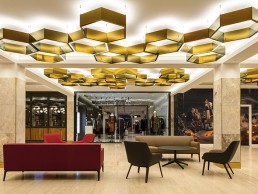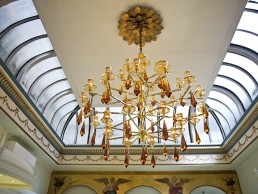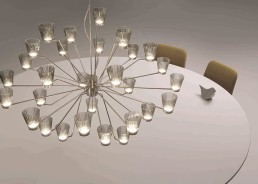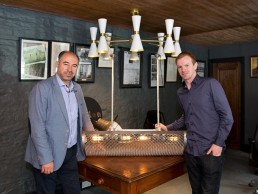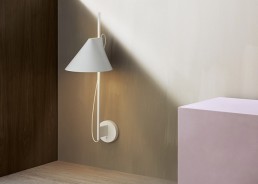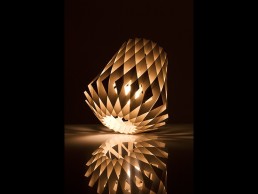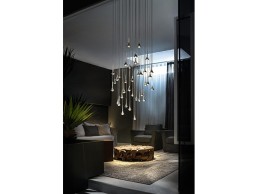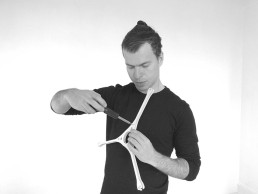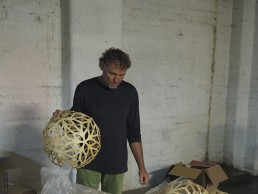Claste introduce Heart of Gold table lamp
Iconoclastic furniture brand Claste, introduce Heart of Gold, a striking table lamp made from onyx and available in white, green and pink.
Based in Montreal, Claste works closely with the finest artisans at all stages of the development process. Every step from design conception to finishing is analyzed and refined ensuring that all their work is infused with a unique expression of ingenuity and permanence.
By combining an in-depth knowledge of traditional techniques of craftsmanship and artistry Claste has created a collection which blends the familiar with the extraordinary.
Sunset Walk, UK
In a perfect blend of architectural and decorative lighting, Lighting Design International pieced together a lighting scheme that evokes the very namesake of Milton Keyne's Sunset Walk shopping mall.
Shopping mall consumers want their overall experience to be one of visual stimulation and luxury. This was the premise behind the refurbishment of Sunset Walk at Centre MK in Milton Keynes, UK, by British architects Rawls & Co. Combined with a well-designed lighting concept delivered by designer Graham Rollins at Lighting Design International (LDI), the overall scheme incorporates strong design elements and a level of detail that makes the refurbishment stand out from the crowd. Unique in its design, Centre MK is a Grade-II listed building that was originally recognised for its use of daylit arcades, elegant steel framed design and a mirrored exterior façade. It was hailed as a ground breaking design when it opened in 1979 and retains its architectural principals today.
The shopping centre is 1km long and 116m wide, and houses over 200 stores, with the refurbishment covering just less than a quarter of the mall’s overall circulation.
LDI was invited to work on the project by Rawls & Co following a previously successful collaboration on another mall retail project. Rollins told darc: “For this project, the brief was consistent and clear from the very start, enabling LDI to develop a clear lighting strategy.”
The design enhances daytime and evening ambiance, comfort and wayfinding by smoothing and balancing the transitions from natural to artificial lighting, as customers move around the centre during the day, and as the daylit arcades transition to night.
Lumen depreciation and fitting maintenance had left large contrasts between the high ceiling daylit bright arcades, and lower ceiling artificially illuminated areas during the day. This was one area the LDI scheme had to address to achieve better balance and more apparent brightness to the lower ceilings. Conversely, during the evening, the higher ceiling areas were not as luminous as the lower ceiling areas, due to lighting throw distance, and difficult maintenance access to the fittings at high level.
While providing scene controlled balanced lighting was a prerequisite to the actual design, it was also important for the final lighting scheme to provide a touch of glamour and interest, elevating the retail experience beyond standard shopping centre expectations. The scheme intended to enhance the appearance and appreciation of the refurbished zone, making it a destination within the centre as a whole.
LDI paid special attention to the entrance atriums to provide a strong visual presence for the centre when viewed from a distance to entice shoppers.
Grand gold finished geometric 'kites' were proposed by the architect to emphasise the large volume entrance atriums, and to bring identity and presence to the centre from the adjacent roads and paths. “The architect’s vision for the project had
always included a sea of hexagons and they needed a lighting designer to develop this concept while technically designing these fittings,” said Rollins. “The decorative vision needed developing into a holistic architectural lighting scheme to provide the correct lighting levels, balance and surface illumination.”
The kites lead the visitor from the high ceiling atrium through to the lower ceiling mall, where their golden tone is echoed in the bespoke mirrored gold hexagonal ceiling lights. A total of 960 hexagon lights were installed throughout the mall, to lead the customer through the newly refurbished areas, while providing uplight and downlight along with visual interest to the space.
The hexagons were developed by LDI in conjunction with Mike Stoane Lighting, and come in three styles; 180mm deep uplighting only, 80mm deep uplighting only and 180mm uplighting and downlighting. These three hexagon styles are swathed in a seemingly random pattern throughout the mall circulation, providing a sculpted landscape of mirrored gold and light to the ceiling. The hexagons in conjunction with beam concealed linear uplighting from ACDC ensure the ceiling plane is bright and fresh during the day, in comparison to the daylight in Sunset Walk and the entrance atriums.
Mike Stoane’s uplighting of these structures using bespoke track mounting spotlight systems provide high contrast dramatic warm white lighting to the kites from the perimeter columns. 2,700K was selected to bring out the kites’ rich gold finish against the 3,000K lighting used for other lights in the project. A special bar mounting system was developed to clamp to the column, allowing maximum fitting adjustability without invasive fixings on the listed columns. An array of large Moooi Raimond pendants were also used to provide sparkle and reflection against the gold finish of the kites and polished beaten metal ceiling panels.
Naturally this installation didn’t come without its challenges, as Rollins explained: “The main challenge was designing such a large number of decorative hexagonal pendants, which would need to be simple and easy to install, while exuding glamour and quality. The mirrored gold stainless steel finish brought durability and elegance, tying the fitting into the architectural finishes. Through three rounds of mockups, the pendant suspension and lighting characteristics were focused to ensure high quality light and functional standards.
As the pendants are so abundant, and constructed from mirrored gold stainless steel, their loading on the ceiling was significant. The team was not able to reinforce the plasterboard ceiling with ply due to fire loadings, and hence specialist plasterboard fixings were reviewed and pull tested to ensure the installation method.”
The hexagons provide the majority of functional and decorative lighting through the centre of the mall halls, and are supplemented by DAL deep cone visual performance X161 downlighters to the high traffic perimeter walkways. The lighting is controlled by a Helvar architectural dimming system, enabling LDI and the client to tailor each space to react to the amount of daylight, at different times of the day or year through an astronomical time clock.
The control system scenes are automatic and save energy, while enabling the lighting intensity to be adjusted for better synergy between daylight and artificial light. As a trained product designer, Rollins found a different challenge in his designs for Sunset Walk: “It was a great opportunity to work on such a large number of bespoke luminaires. The considerations when designing towards such a large number of fittings are quite different, to when working on a single bespoke feature. I really enjoyed considering the installation method, maintenance aspects, time of installation and overall wattage and performance of the hexagons. I feel they work really well to bring the wow factor to the lighting scheme as a whole.”
In this intelligent cooperation between architectural and decorative lighting, customers to Sunset Walk shopping mall are met with more than they could have imagined, as they effortlessly navigate the space under the guidance of light.
www.lightingdesigninternational.com
Moser Crystal
(UK) Moser Crystal are hosting an exhibition at London’s leading luxury tableware retailer, Thomas Goode to celebrate 160 years of supreme craftsmanship. darc interviewed Lukas Jaburek, Design Director of Moser about the event and what the chandelier means to modern design.
What can visitors expect from the exhibition?
This is the first and largest exhibition Moser has ever had. The exhibit brilliantly illustrates the symbiotic connection between the past and present, tradition and vision, form and content. At a symbolic level the collection is also a celebration of human courage, diligence and self-discipline, a tribute to Ludwig Moser who laid a solid foundation for one of the world’s best-known brands of luxury glass. The exhibition shows a selection of masterpieces inspired by the company’s rich history.
The most important examples of Moser’s historical archives were lovingly revived by contemporary masters using crystal craft and a unique colour palette meticulously handed down from generation to generation. We created works for Moser 2017 that are inspired by the most successful and significant works from the period of painted historic motifs, engraved Art Nouveau plant decorations and gilded African scenes, which brought the glassworks fame.
How was the opening event received?
The event was a great success in generating awareness of Moser’s exceptional hand craftsmanship and heritage. It’s often hard to comprehend without seeing it in person that handmade really means handmade. The bespoke palette of colours used by Moser have stayed the same for hundreds of years yet appear as modern as anything against today’s contemporary hues which is quite extraordinary.
The Ludwig chandelier is at the centre of the exhibition, what can you tell us about the production and design of this impressive piece?
This chandelier has been in the making for almost 12 months with around with around 40 people involved in its creation. This unique piece is 220cm high by 190cm diameter and weighs 200kg it comprises of 133 drops of hand blown and hand cut crystal in the golden colour of Moser’s topaz, which are further decorated with oroplastic and painted with 24-karat gold. The chandeliers arms are also thickly gilded in the same 24-karat gold.
What do you think chandeliers bring to modern design?
Chandeliers and lighting in general bring to modern design and architecture an extraordinary atmosphere, individual style and spirit. These distinctive and fundamental elements of interiors, perfectly connect crystal with light and maximise its characteristics, nowadays chandeliers have become more of a lighting object custom made for the discerning client, bringing about the need for the development and use of new technologies, moving the boundaries between art and design. For this reason we like to experiment and create these unique light experiences.
The exhibition, including the unique Ludwig crystal chandelier, will be on view at the institution that is Thomas Goode until September of this year.
New product: Canaletto by Icone Luce
Icone Luce’s new collection of suspended and wall lamps depict the grace and craftsmanship Murano is famous for.
Both the suspended and wall version have a system of indirect lighting diffusion with LED 220V that does not require a power supply and is available in 3000K and 2700K LED colour temperature.
Available in a pewter lacquer finish with smoked lighting diffusers, brushed bronze lacquer with crystal lighting diffusers and white lacquer with white lighting diffusers offering various possibilities for any style of décor.
Mullan Lighting secures major contract in Dubai
(UAE) Mullan Lighting has secured a major contract in Dubai that is close to completion.
The contract sees the company manufacture 1,500 custom-made outdoor light fittings bound for La Mer a mixed-use development spread across 9.5 million sq. ft. of existing and reclaimed land. It will feature distinctive retail and leisure attractions, an integrated outdoor living environment and engaging beach activities. La Mer is poised to set new global benchmarks in beachfront development.
Mike Treanor, Design Director at Mullan Lighting, spoke of the challenges that the La Mer project presents: “La Mer is certainly one of the most challenging projects we’ve ever worked on. We’re working with a lot of different materials and colour finishes that all have to be researched and sourced. A very tight project deadline has forced us to remain focused in terms of prototype development, testing and final manufacture. All 1,500 light fixtures are to be installed outdoors too so they must be able to withstand moisture, the salt sea air and intrusion from wind-blown sand. This adds another dimension to overcome.”
Mike added, “We relish the challenge. With my own background in architecture and a dedicated team of designers we create design solutions on a daily basis to overcome these challenges.”
This will be the second major contract the company has secured in Dubai; last year they completed a significant lighting project at LEGOLAND Dubai.
Skandium launches new retail concept
(UK) - Skandium celebrates its new concept store, the Skandium Townhouse, with a light installation by GamFratesi and the world launch of the limited edition Louis Poulsen PH pendant lamp During this year’s London Design Festival.
Skandium will officially launch its new retail concept, the ‘Skandium Townhouse, the vision will see a four-storey house at 31 Thurloe Place, South Kensington, transformed into a brand-new design destination.
Working within the natural scale of a home, Skandium will create room sets designed to inspire shoppers and demonstrate the unique character of Scandinavian living.
It follows the August opening of Skandium’s new homeware mecca, in a two-storey building at 35-36 Thurloe Place – directly opposite the Townhouse - that showcases their range of soft furnishings, accessories and one of the largest collections of Scandinavian lighting in London.
Once named ‘London’s most discreetly fashionable design shop,’ the new Skandium stores – together constituting 5,500sq ft. of retail space - will continue to celebrate Scandinavian design with passion, selling a mix of modernist designs from Scandinavia, as well as from companies such as Knoll and Vitra, its own line, Studio Skandium, and a curated selection of new Scandinavian design talent.
During the London Design Festival, the Skandium Townhouse will have a fitting inauguration, with an exciting take-over by design duo GamFratesi, who will present their new Yuh collection for Louis Poulsen in a conceptual experience that draws on architectural structures inspired by Japanese paper art.
Key Lighting from London Design Fair
(UK) - From the 21–24 September 2017, the London Design Fair will host the largest collection of international exhibitions, designers, brands, country pavilions and galleries, set in one dynamic location during the London Design Festival.
Launching a number of brand new show elements, this year’s Fair will pack a creative punch.
As the London Design Fair continues to grow, they are adding exciting new and relevant elements, and building on already successful components: for example, the Guest Country pavilion, Material of the Year and the British Craft Pavilion.
With these specialisms come the need for specialists, and the 2017 Fair will bring first-rate curating and commissions. Hole & Corner will curate the British Craft Pavilion and Sight Unseen will curate this year’s Guest Country pavilion: USA.
Ariane Prin is also set to create a site specific Jesmonite installation for Material of the Year.
Messler Gallery announces Wooden Lamps exhibition
(US) Curated by internationally renowned furniture and lamp designer Christopher Poehlmann, the show brings together a wide spectrum of technique and concept.
Christopher Poehlmann explains: “over the past two decades of working in the worlds of design and fine craft, I have come across many fine examples of light fixtures made from wood, but rarely is there an opportunity such as this, to present theses beautiful pieces based on their materiality. I am so pleased to be able to bring this fine group of designers and makers together to show a cross section of the possibilities that wood offers as a medium to express light.”
This exhibition showcases the exemplary work of 23 makers from six countries and includes techniques ranging from delicate marquetry, CNC laser cutting and coopering to veneering, bending and turning, along with other traditional fabrication techniques.
The exhibition opens September 22, 2017 until January 3, 2018.
Exclusive Lighting Distributor Launches for US Market
(US) Former President and Founder of Leucos USA, Josie A. Anthony and former Vice President of Sales at Pablo Designs, Blair H. Hutkin launch JB Lighting Collection, an exclusive distributor of select international brands in the North American market.
JB Lighting Collection addresses the needs of designers, architects, high0end retailers and discerning residential clients by offering preeminent international brands that complement contemporary companies.
Anthony and Hutkin explain: “Our mission is to combine the right brands with unparalleled support and knowledge, making the customers lighting decision effortless, while providing out partners with a powerful channel to grow their business in this highly competitive market.”
The company’s comprehensive portfolio launches nationwide this month, starting with the exclusive U.S. distribution of Studio Italia Design. In the next few months’ partnerships with other well-known lighting companies will be announced.
A Vegan Approach to Light
Sustainable design goes without saying, right? It should be something everyone strives towards, right? According to architect and designer Joost Heremans, sadly, not all of the lighting industry is quite there yet.
Muunlight.com is a London-based business that promotes sustainable design and manufactures zero-waste, environmentally friendly lighting products.
Set up by architect and designer Joost Heremans, previously Associate Partner at Fosters+Partners, the Muunlight pendant lampshade – a reinvention of the traditional pendant – is the company’s most recent launch and at 2.4m, is one of the largest pendant lampshades on the market. The minimal design looks something similar to a floating zeppelin: defying gravity. Delivered as a flat pack, with assembly instructions available online to avoid the printing of paper, the engineered timber structure is super lightweight, while the screen is made of Japanese Kosuke paper.
Sustainability is implemented throughout the design process – from concept ideas to the detail. “Sustainability is always in the back of our minds,” Heremans tells darc. “To achieve sustainability, we need to make it easy, attractive and affordable for people everywhere to lead whole sustainable lifestyles – not just green buildings, but wider infrastructure, products and services as well – all wrapped up in a simple and clear story that people can understand.
“The ten principles by One Planet Living is a target we aim for; using sustainable and healthy products such as those with low embodied energy, locally sourced, made from renewable or waste resources. We aim to reduce waste, reusing where possible and ultimately sending zero waste to landfill.”
Not your most typical of business plans, the Muunlight workshop is based out of a 200-year-old farmhouse, which has been converted into a self-sufficient eco-community, producing their own food and energy with no waste. All profits from the Muunlight sales go to tree planting projects around the world.
As an architect and designer, Heremans’ credentials are beyond dispute. His first role at Foster+Partners in 2002 was to work on what would become an award-winning project, the Leslie L Dan Pharmacy building at the University of Toronto, Canada.
It was an auspicious start to what would become an impressive roll call of over 50 major projects; from New York to Astana… A mixed use tower in Istanbul; a carbon-neutral resort in Cuba; the five-star ME hotel in central London; a design for a 600m tower in Chicago; a headquarters tower in Calgary, Canada; the 2022 World Cup football stadium in Qatar; a children’s hospital for the University of Iowa; a 300m high residential tower in Beijing and the new airport in Mexico City to name but a few.
“Architecture and lighting design are complementary,” continues Heremans. “When they work together, it touches the senses. In Burgundy, there is a place called Vezelay, a small, picturesque town on a hillside. On the top of the hill sits the Basilica, it catches the light beautifully. The windows are positioned in such a way that at lunchtime, during the summer solstice, the sun projects nine light beams into the middle of the Basilica. It never stops amazing me. The art of architecture is there to make the light visible and the art of lighting design is there to make the architecture visible.”
The idea for the pendant lamp dates back to 2010, Heremans tells darc more: “I cannot deny the Japanese influence: the translucent paper screens, the minimal lightweight timer structures, the sharp daylight, the praise for the shadows… the long flights. The idea was to create something large and lightweight – defying gravity, almost floating and part of the challenge was to design a timber structure with minimal material used.”
With the use of full size models and mock-ups, the options were analysed in three dimensions. Seven years and more than 20 full sized mock-up models layer, Heremans reached the point where he couldn’t make it ant lighter, the engineering was stretched to its limits.
“Creating sustainable design is like eating vegan. It is healthy for yourself and healthy for the planet. There are only advantages, but it does require some effort.”
Confronting the copiers
Some people, whose house has been burgled, say that it feels like they have been personally violated, that a part of themselves has been ripped out. I felt like this when I first saw photos from the Hong Kong Lighting Fair, of the Lightingbird stand full of my lights. Those people proprietarily standing in front of MY lights were blatant thieves who had the gall to display their stolen goods in public. I wanted to rush over and tear down the ugly fakes - to stamp on them, right there in front of the crowds. OK, so this is an emotional response and it is probably not acceptable in today's commercial world, but it is too easy to forget just how much our designs are actually a part of us, and the implications of such a relationship.
Later I did have the unpleasant satisfaction of publicly jumping on a lot of fake copies of my lights, which were sadly only a fraction of the total that we have taken out of circulation. It was ‘unpleasant’ because I hate waste of any kind, even if the goods are illegal. It hurts me that the planet’s precious resources have been so unnecessarily squandered for quick and reckless profit. And therein lies the crucial difference between my manufacturing operation and that of the copyists: I care enormously, whether it is for the environment that supports us, or for the people on whom I have an effect, even for future generations. I am prepared to spend more money on better materials if they are environmentally cleaner, to fit air filters to reduce air pollution, to use FSC cardboard and only biodegradable plastic in packaging, to ship kitset to reduce freight to the minimum, to give those who work for me the best care I can, and so on.
Not so the copiers, who couldn’t care less about any of these things - the only thing they care about is profit . . . At anyone’s expense: mine, their countrymen dying of respiratory disease from their pollution, or the right of future generations to the bounty we have enjoyed. They will use the cheapest materials and packaging, not the most sustainable; they will operate unfiltered and dangerously unprotected machines, and their workers will be paid as little as possible. We have seen one of their lights and it was badly made, with plywood too thick so that it sometimes broke rather than bent, a boxful of abominable polystyrene and uncertified electrics, making it potentially dangerous to the user. We questioned the importer about this, saying our electrician was reluctant to connect the light, only to be told: “Find another electrician!”
I have zero sympathy for the callous and devious companies who steal others’ ideas and strip them of all value in order to be able to market large volumes of trashy consumer goods. And I don’t have much more sympathy for greedy consumers who buy this stuff, asserting their right to cheap goods, without any care for where they may have come from, or any damaging effect they may have. They choose to ignore the reasons why my lights may be a little more expensive (though actually cheaper in the long run) or the fact that copies are fake and illegal. We have tried to stop the manufacturers in China, but the whole corrupt economy protects them, while they lie repeatedly to us about ceasing. So now we concentrate our efforts on those who import into our markets, in countries that have more respect for IP. Generally this works, but it is a constant and frustrating drain on resources, a leech sucking out some of our lifeblood.
Another conveniently ignored aspect of the copying economy is the way in which it hurts the design industry by shutting out the next generation of designers. There are too many stories of young designers seeing their designs being offered in production only six months after they first exhibited them at a trade show. One friend of ours told us that a hotel chain had asked him to drop the price of his lights for them, or else they would get them made themselves in Asia! It is extremely difficult and expensive for young designers to get a new idea into production and market ready, especially with the heavy up-front certification costs required for lighting. They are defenseless and there is no way they can afford to fight the copiers, so they end up giving up altogether, which is everyone’s loss.
I think we have to be much more open and outspoken about this industry of theft. The more it is exposed, the more those who support it will be shamed. There is nothing clever about getting such an apparently cheap bargain; there should only be stigma. Like someone being caught wearing a ‘fake Rolex,’ it makes them look worse than if they had no watch at all. If cheapskate companies wish to persist in making shoddy, polluting goods for gullible consumers, there is no way - for the moment - that they can be stopped. But they do not have to steal my designs to do it. And if they do, I will fight them and, as a number of companies will attest, it will cost them tens of thousands of dollars.
Seyhan Özdemir
Internationally renowned, Istanbul-based design studio Autoban works across architecture and interiors, product and design, forging a reputation for thoughtfulness, experimentation and craftsmanship.
darc talks to co-founder Seyhan Özdemir on the history of the studio and what the future holds.
With a portfolio ranging from transportation and commercial to retail and office developments, Autoban's work is typified by familiar forms and materials repurposed in vital, contemporary ways.
Their work has redefined Istanbul’s cityscape, including numerous hospitality, retail, residential and public realm developments, and is now also found in London, Madrid, Hong Kong, Moscow and China, as well as Azerbaijan.
Founded in 2003 by friends Seyhan Özdemir and Sefer Çağlar, who met while studying at Mimar Sinan University, Seyhan studying architecture while Sefer studied interior design, after graduation Özdemir and Çağlar worked together and separately, for other architecture firms for five years before finally deciding to start their own design studio. “Our first office was in Galata, a historic neighbourhood with a genuine Istanbul vibe,” Özdemir tells darc. “This unique location enabled us to understand craftsmanship and local manufacturing techniques.
The biggest disadvantage we faced at the time was not having any industry support, but that eventually became an advantage for us because of the great craftsmanship these local workshops offered. We’ve managed to keep our designs handcrafted ever since and away from mass production, it has since become the calling card of Autoban.” Çağlar was born into a family of furniture designers so design felt like his natural course and was something he was passionate about from an early age, while for Özdemir the concept of beauty was something that intrigued her since childhood. “I think for both of us everything started with passion, the rest was the faith we showed each other, dedication and the hard work we put in.
A fascination with common and unusual materials has since become the studio’s trademark, skilfully and instinctively pushing them to their full potential. Forward looking and context-sensitive, human and spatial, micro and macro, Autoban embodies all of these traits and find their balance, creating unique spaces in the process. Çağlar’s and Özdemir’s obvious skillset in experiential design and keen interest in the transport business, has led them down some eclectic paths. In 2011 Autoban designed the Turkish Airlines CIP Lounge at Istanbul Ataturk Airport which won Skytrax World’s Best Business Class Lounge Awards. Then came the Heyder Aliyev International Airport in Baku Azerbaijan where they were held responsible for the interior design of the new terminal building that earned them a Red Dot Award. Recently they were tasked with the interior design of the Yacht Aquarius, a project that was honoured at the International Yacht & Aviation Awards 2017.
This year shows no sign of slowing down for the Autoban team with several diverse projects in the works worldwide.
“We have been commissioned to reinterpret the interiors of the first art deco hotel in Prague; a passenger terminal for cruise liner; and two resorts in the Maldives. We are currently working on the interiors of a 40ft motor yach and recently created the Wish Machine Installation, a design project we undertook as Turkey’s contribution to the latest Design Biennale, it was very inspiring, art is a great source of inspiration for us,” admits Özdemir. “We also find inspiration in the desires of the client, the environment in which the space resides or the history of the building. We approach projects as storytellers, we seek to create a design full of character set up around a story that fosters memorable experiences and imagination.”
For Çağlar and Özdemir lighting is a key element in bringing that story together, describing it as transformative, magical and evocative. “We use light to expand the boundaries, sometimes to emphasise the material behind an barchitectural feature, or to illuminate a detail to make it the focal point.” Özdemir explains. “It is different to any other form of design because it embraces functionality but it also involves a kind of magic. Light is invisible until it strikes an object or surface, when it is turned off it disappears.”


